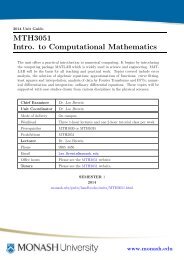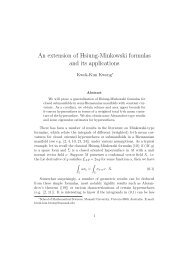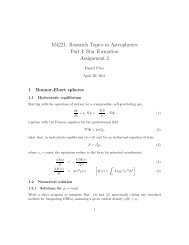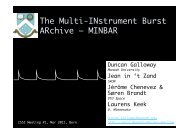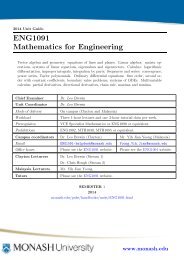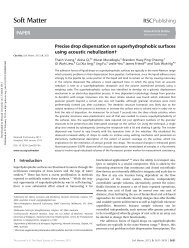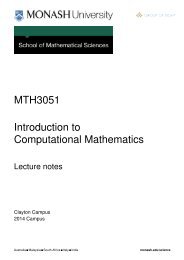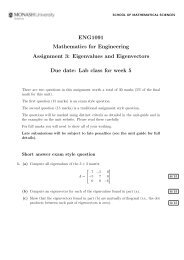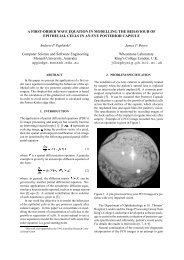Intersection theory on moduli spaces of curves ... - User Web Pages
Intersection theory on moduli spaces of curves ... - User Web Pages
Intersection theory on moduli spaces of curves ... - User Web Pages
Create successful ePaper yourself
Turn your PDF publications into a flip-book with our unique Google optimized e-Paper software.
1.2. <str<strong>on</strong>g>Intersecti<strong>on</strong></str<strong>on</strong>g> <str<strong>on</strong>g>theory</str<strong>on</strong>g> <strong>on</strong> <strong>moduli</strong> <strong>spaces</strong> 17Therefore, the family we have described is precisely the universal family C 0,4 → M 0,4 . However,as noted earlier, <strong>on</strong>e may interpret this family as the forgetful map M 0,5 → M 0,4 . So wemay now c<strong>on</strong>clude that M 0,5 is equal to CP 1 × CP 1 blown up at the three points (0, 0), (1, 1)and (∞, ∞).Example 1.7 (The <strong>moduli</strong> space M 1,1 ). The uncompactified <strong>moduli</strong> space M 1,1 is essentiallythe <strong>moduli</strong> space <strong>of</strong> complex elliptic <strong>curves</strong>. Every elliptic curve arises as a 2-fold branchedcovering <strong>of</strong> CP 1 doubly ramified over ∞. Topological c<strong>on</strong>siderati<strong>on</strong>s force such a covering tohave three additi<strong>on</strong>al ramificati<strong>on</strong> points which we can send to 0, 1 and λ /∈ {0, 1, ∞}. The affineequati<strong>on</strong> for such a curve is y 2 = x(x − 1)(x − λ), and we let the marked point corresp<strong>on</strong>d tothe unique point <strong>on</strong> the curve over ∞. Note that there was some choice in normalising theramificati<strong>on</strong> points, so we expect an S 3 symmetry to appear. C<strong>on</strong>cretely, this manifests as <strong>on</strong>e<strong>of</strong> the six transformati<strong>on</strong>s given by λ ↦→ λ, λ ↦→λ 1 1λ−1, λ ↦→ 1 − λ, λ ↦→1−λ, λ ↦→λandλ ↦→λ−1 λ . This symmetry can be dealt with by associating to each curve y2 = x(x − 1)(x − λ)its j-invariantj(λ) = 256 (λ2 − λ + 1) 3λ 2 (λ − 1) 2 ,which satisfies j(λ) = j(λ ′ ) if and <strong>on</strong>ly if λ ′ ∈ {λ,λ 1 , 1 − λ, 11−λ , λ−1λ , λλ−1}. C<strong>on</strong>versely, it iswell-known that the j-invariant distinguishes between elliptic <strong>curves</strong> which are not isomorphic.Therefore, we deduce that M 1,1∼ = C.There is precisely <strong>on</strong>e stable nodal curve <strong>of</strong> genus 1 with <strong>on</strong>e marked point and this corresp<strong>on</strong>dsprecisely to the j → ∞ limit, so M 1,1∼ = CP 1 . Our discussi<strong>on</strong> up to this point has completelyignored the orbifold — or stack — structure <strong>of</strong> M 1,1 . The case <strong>of</strong> M 1,1 is excepti<strong>on</strong>al since everygenus 1 curve with <strong>on</strong>e marked point has at least <strong>on</strong>e n<strong>on</strong>-trivial automorphism — namely, theelliptic involuti<strong>on</strong>. Furthermore, the curve with j-invariant 0 actually has an automorphismgroup isomorphic to Z 6 while the curve with j-invariant 1728 has an automorphism groupisomorphic to Z 2 × Z 2 . Therefore, every point <strong>of</strong> M 1,1 is an orbifold point <strong>of</strong> order 2, apartfrom <strong>on</strong>e point <strong>of</strong> order 4 and <strong>on</strong>e point <strong>of</strong> order 6.1.2 <str<strong>on</strong>g>Intersecti<strong>on</strong></str<strong>on</strong>g> <str<strong>on</strong>g>theory</str<strong>on</strong>g> <strong>on</strong> <strong>moduli</strong> <strong>spaces</strong>Characteristic classesGiven a space with interesting topological structure, <strong>on</strong>e <strong>of</strong> the first compulsi<strong>on</strong>s <strong>of</strong> a geometeris <strong>of</strong>ten to calculate associated algebraic invariants. And so it is with <strong>moduli</strong> <strong>spaces</strong> <strong>of</strong> <strong>curves</strong>,except for the fact that their homology and cohomology are notoriously intractable in general.However, a great deal <strong>of</strong> progress can be made in this directi<strong>on</strong> if <strong>on</strong>e is willing to adopt thefollowing two simplificati<strong>on</strong>s.



